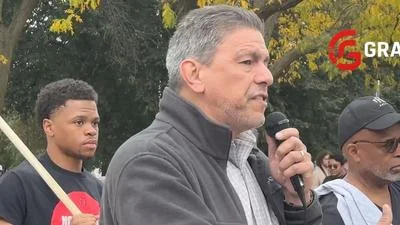City of Wheaton City Council Planning Session met April 26
Here is the minutes provided by the council:
1. Call to Order
The Wheaton City Council Planning Session was called to order at 7:00 p.m. by Mayor Suess. The following were:
Physically Present: Councilman Barbier
Councilwoman Bray-Parker
Councilwoman Fitch
Councilwoman Robbins
Councilman Rutledge
Mayor Suess
Councilman Zaruba
City Staff Physically Present: Michael Dzugan, City Manager
John Duguay, Assistant City Manager
Robert Lehnhardt, Director of Finance
Daniel Peck, Public Relations Coordinator
2. Approval of April 12, 2021 Minutes
The Council approved the April 12, 2021 City Council Planning Session minutes.
3. Public Comment
There were no public comments.
4. Analysis of Future Funding of Police and Fire Pension Liabilities - Continued Discussion
City Manager Dzugan stated that this was a continuation of the discussion of developing a funding strategy to address the City’s Police and Fire pension liabilities with the goal of achieving more predictable annual payments while reducing future costs. He stated that the City’s actuary, Foster and Foster, and financial bond advisor, Baird, have run a couple of different scenarios on pension obligation bonds using different investment returns. Also, Foster and Foster will present a discussion on open amortization as another funding approach.
Jason Franken of Foster and Foster stated that, as of January 1, 2021, the City currently has approximately $57.9 million in unfunded liabilities in its public safety pension plans and is targeting a 100% funded ratio for both plans by 2040.
Mr. Franken discussed the considerations when selecting an amortization method including establishing the length of the amortization period, deciding upon an open or closed amortization approach, and following a level dollar or level percentage of payroll basis.
Mr. Franken provided a comparison of the City’s current closed amortization method to a 15-year open amortization method. Currently, the City’s closed amortization is funding to 2040 and there is potential legislation to push out the date to 2050. The main problem with closed amortization is you have more volatility as you approach 2040, for example if you have a bad year in 2035 there could be significant contribution increases due to the shorter amortization period remaining. Mr. Franken stated that an open amortization period would be a rolling 15-year amortization period. He stated every year you would be making your payment based on 15 years. If the City were to transition to an open amortization period, there are significant increases in the first 3 years and does not achieve 100% funded status in 2040. He stated this is an approach IMRF is moving to and opponents do not like this approach because it does not get you to 100% by any specific date.
In response to Council questions, Mr. Franken stated that the 4.0% payroll growth rate is the assumption of the increase in payroll for the entire department, not individual salary increases. Salary increases for individuals is a complete separate assumption. He stated the payroll growth rate assumption is only used to determine the amortization payment amount and has no impact on your unfunded liability.
Mr. Franken stated that the City is currently using a closed amortization method with an amortization period lasting through 2040 based on a 4.0% annual payroll growth rate assumption. He stated that this is a backloaded amortization funding strategy where the City’s annual amortization payment increases from $3.7 million in 2021 to $6.5 million in 2040. He stated that if the assumed annual payroll growth rate was lowered to 3.0%, then the City’s annual amortization payment in 2021 increases from $3.7 million to $3.98 million and future annual payments would be more evenly distributed through the remaining years of the amortization period. Or, if the City used a level dollar amortization method or 0.0% payroll growth assumption, the City’s annual amortization payment would increase from $3.7 million to $5.0 million in 2021 and would provide a fixed dollar amount over the remaining years of the amortization period.
Mr. Franken recommended, absent of issuing a pension obligation bond, the City lower the current payroll growth rate assumption from 4.0% to at least 3.0%, but would feel more comfortable at 2.0% or 2.5% because that is where inflation has been at for a while and consider going to an open amortization period no longer than 15 years. Open amortization better aligns the funding of the plan with the benefits being paid from the plan and eliminates the volatility that arises as you get closer to the end of the current closed amortization (2040). If pension obligation bonds are issued, it is important to discuss a funding policy that reduces and eliminates the unfunded liability in an orderly manner.
Mr. Franken presented different funding strategy scenarios using a closed amortization method through 2040 that included: a one-time additional contribution of $6 million to the pension funds in 2021 using General Fund excess reserves; contributing an additional $1.2 million annually for 5 years using General Fund excess reserves; contributing $10 million in 2021 using General Fund excess reserves and Capital Fund reserves and issuing $10 million in General Obligations Bonds to finance capital projects; and issuing a $51.9 million Pension Obligation Bond to eliminate the entire unfunded liability.
Mr. Franken presented the funding strategy scenario of a one-time additional contribution of $6 million to the pension funds in 2021. The $6 million contribution would be allocated based on the total unfunded liability balance of each pension plan, with 74% (or $4.44 million) going to the police pension plan and 26% (or $1.56 million) to the firefighters’ pension plan. Projected annual contribution savings ranges from $422,000 to $854,000 with total gross savings of $11.7 million.
Mr. Franken presented the funding strategy scenario of contributing an additional $1.2 million annually for 5 years to the pension funds beginning in 2021. Projected annual contribution savings ranges from $84,000 to $865,000 and total gross savings of $10.9 million.
Mr. Franken presented the funding strategy scenario of contributing $10 million in 2021 using General Fund excess reserves and Capital Projects Fund reserves and issuing $10 million in General Obligations Bonds to finance capital projects in 2021. Projected annual contribution savings ranges from $2,100 to $1.4 million and total gross savings of $7.9 million.
Mr. Franken presented financial projections using different investment return scenarios of 6.75%, 4.00%, and 2.50% with the issuance of a $51.9 million Pension Obligation Bond (POB) to eliminate the entire unfunded liability using the current closed amortization method through 2040. Each of the POB scenarios assume a 20-year level debt service schedule and an assumed POB interest rate of 2.46%.
Mr. Franken presented a financial projection scenario using an 6.75% investment return, which estimates projected annual contribution savings ranging from $1,500 to $3.3 million and total gross savings of $26.9 million.
In response to Council questions, Mr. Franken stated that the total annual payments to amortize the unfunded liability thru 2040 totals $96.8 million which includes approximately 50% in interest costs or $45 million.
Mr. Franken presented a financial projection scenario using an 2.5% investment return, which estimates projected annual losses ranging from $182,000 to $700,000 and total gross loss of $6.7 million.
In response to Council questions, Mr. Franken stated that the total funded status of the City’s Police and Fire pension plans would be higher in 2040 through the issuance of a Pension Obligation Bond as long as you continue to make future annual contributions and not take pension holidays.
Mr. Franken presented a financial projection scenario using an 6.75% investment return using a 15-year open amortization approach, which estimates total gross savings of $1.2 million and does not achieve 100% funded status by 2041 with an unfunded liability of $37.1 million
In response to Council questions, Mr. Franken stated that the City’s contribution savings would increase if the City used a 15-year open amortization method and a 0.0% annual payroll growth assumption with the issuance of a Pension Obligation Bond as opposed to a 15-year open amortization method with a 4.0% annual payroll growth rate assumption.
In response to Council questions, Dalena Welkomer of Robert W. Baird & Co. stated that in their findings on the three Pension Obligation Bonds they have done since November, that the rating agency is net neutral on the concept so long as you are structuring them in the fashion as has been presented today. You are assuming close to level annual debt service, not deferring principal, and not structuring them to achieve upfront budget relief. You are taking it as a long-term financial solution to funding our unfunded liability. In two of the POB issues, the ratings were affirmed and for the third it was an inaugural credit rating with no negative feedback.
In response to Council questions, Ms. Welkomer stated that the City would be able to refinance the bonds in the future if an opportunity to achieve a better interest rate is available.
In response to Council questions, City Manager Dzugan stated that the funding strategy of contributing an additional $1.2 million annually for 5 years would provide the City with more flexibility. City Manager Dzugan stated we have to have a policy that we try to stick to, but future councils could change the policy. In response to Council questions, Mr. Franken stated that if the City missed or ceased making the additional contributions after a few years then the overall savings would be less.
The Council requested that City staff concentrate on the funding strategies of a one-time additional contribution of $6 million; contributing an additional $1.2 million annually for 5 years; and issuing a Pension Obligation Bond. Also, staff look at the payroll growth assumption, amortization approach and how those might look and drill down to what it means to the City on the annual budget.
5. City Council/City Staff Comments
Councilman Barbier congratulated the Wheaton North High School football team for winning the DuKane football conference championship and thanked Wheaton-Warrenville South High School football coach, Ron Muhitch, for his time as the school’s head football coach.
Mayor Suess notified the community that the tents on Hale Street will be back up again this weekend and expressed his satisfaction for their return.
Mayor Suess mentioned that he and Councilwoman Bray-Parker attended a new business opening for Pedego Electric Bikes Wheaton, 128 W. Liberty Drive, and welcomed them to the community.
Mayor Suess notified the community that the Wheaton Park District would be hosting a Covid-19 vaccination clinic on Friday, April 30 from 8 a.m. to 12 p.m. with appointments being necessary. He stated that more information was available on the Wheaton Park District’s Facebook page, and information would also be shared through the City’s communications channels.
Mayor Suess thanks Councilman Zaruba and Councilman Rutledge for their service and contributions as members of the City Council.
6. Adjournment
The meeting was adjourned at 8:56 p.m.
https://www.wheaton.il.us/AgendaCenter/ViewFile/Minutes/_04262021-1636






 Alerts Sign-up
Alerts Sign-up